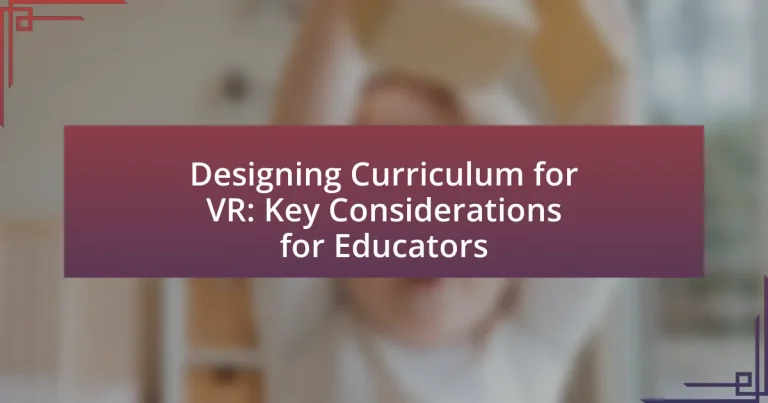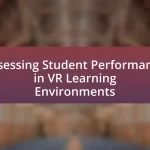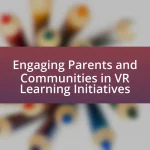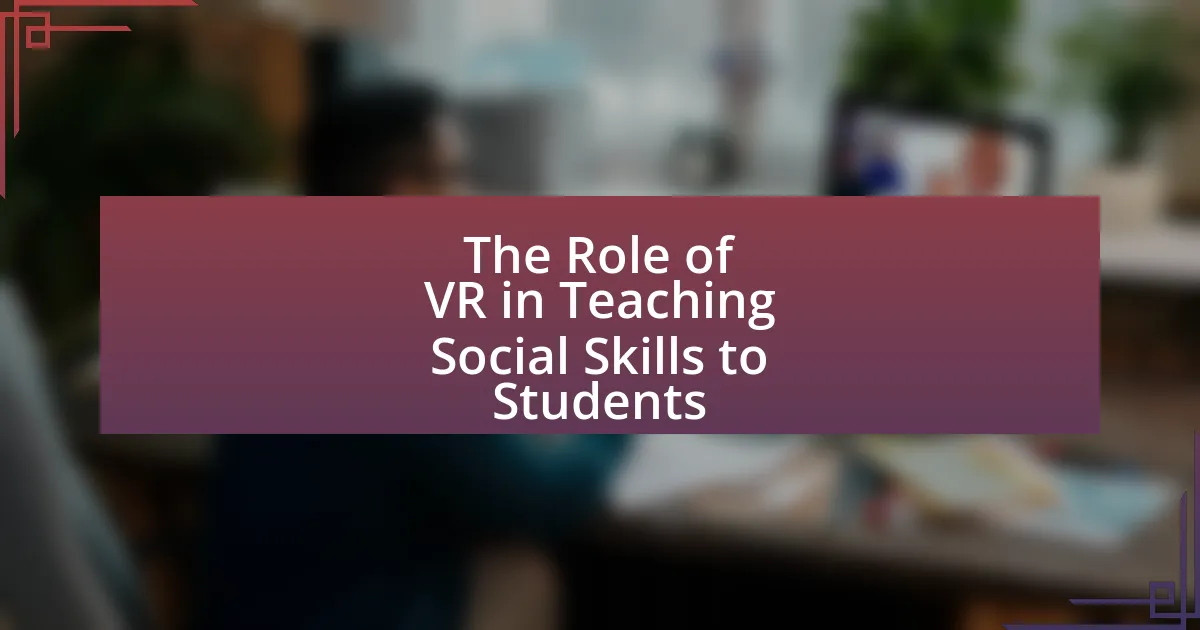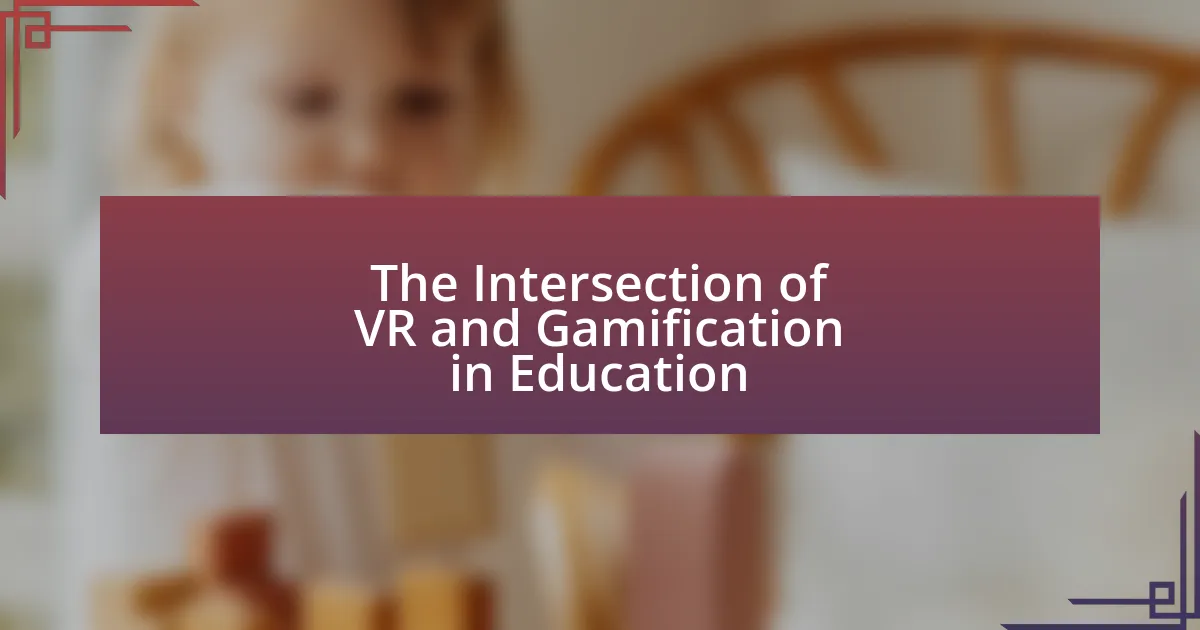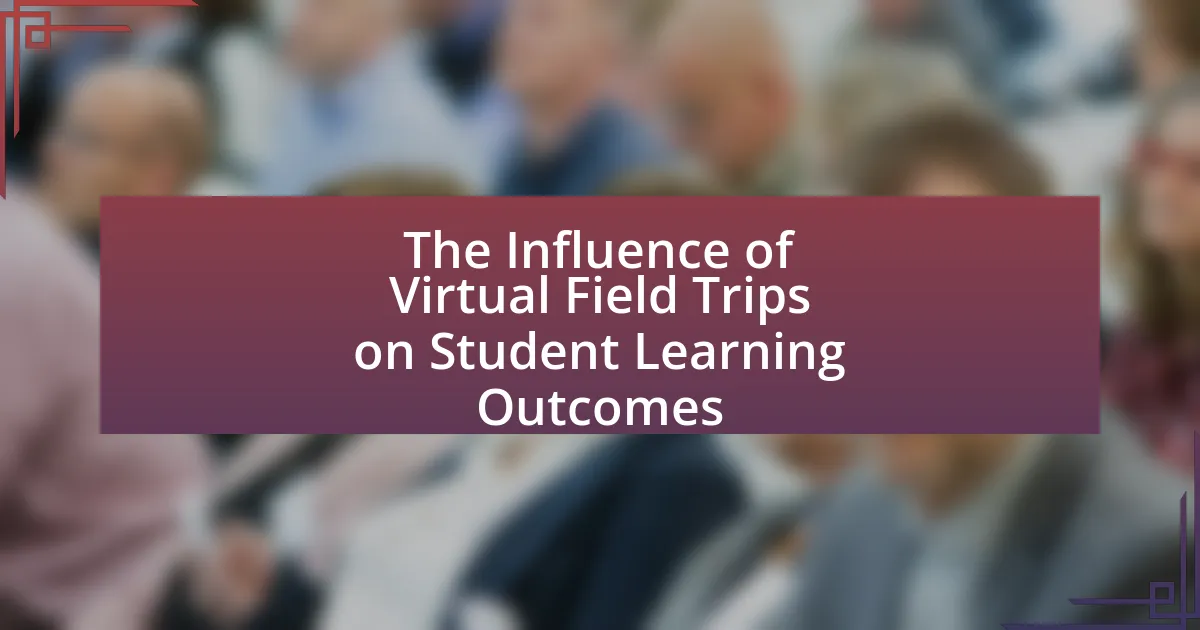The article focuses on the fundamental principles and considerations for educators in designing curriculum for virtual reality (VR). It outlines key elements such as immersion, interactivity, learner-centered design, and alignment with learning objectives, emphasizing their impact on student engagement and knowledge retention. The discussion includes how VR technology influences curriculum design, unique features that enhance learning experiences, and strategies for effective implementation. Additionally, it addresses challenges educators face, assessment adaptations for VR learning, and resources available for developing VR curricula, providing a comprehensive overview of best practices in integrating VR into educational settings.
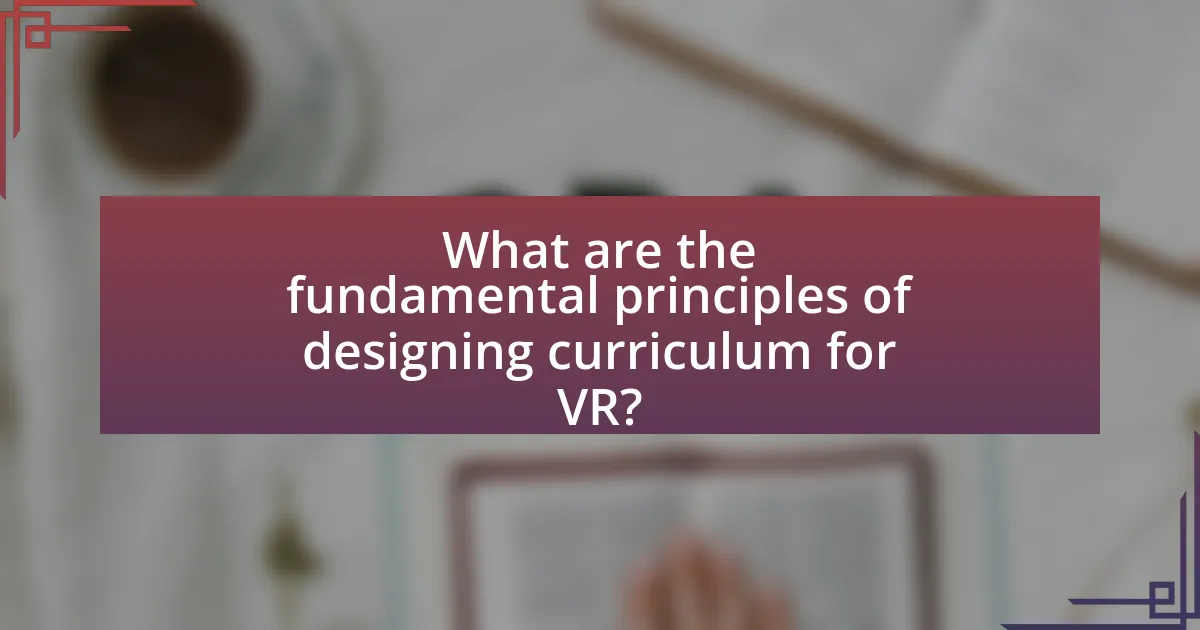
What are the fundamental principles of designing curriculum for VR?
The fundamental principles of designing curriculum for virtual reality (VR) include immersion, interactivity, learner-centered design, and alignment with learning objectives. Immersion ensures that learners are fully engaged in a realistic environment, enhancing their experience and retention of information. Interactivity allows learners to actively participate in their learning process, fostering deeper understanding through hands-on experiences. Learner-centered design focuses on tailoring the curriculum to meet the diverse needs and preferences of students, promoting personalized learning pathways. Finally, alignment with learning objectives ensures that the VR experiences are directly connected to the educational goals, facilitating measurable outcomes. These principles are supported by research indicating that immersive and interactive learning environments significantly improve knowledge retention and engagement among learners.
How does VR technology influence curriculum design?
VR technology significantly influences curriculum design by enabling immersive learning experiences that enhance student engagement and understanding. This technology allows educators to create interactive simulations and virtual environments where learners can practice skills in real-world scenarios without the associated risks or costs. For instance, studies have shown that students using VR for medical training demonstrate improved retention of complex procedures compared to traditional methods. Additionally, VR facilitates differentiated instruction, catering to diverse learning styles and needs, which is supported by research indicating that immersive environments can lead to higher motivation and better academic outcomes.
What are the unique features of VR that impact learning experiences?
Virtual Reality (VR) enhances learning experiences through immersive environments, interactivity, and experiential learning. Immersive environments allow learners to engage in realistic simulations, which can improve retention and understanding of complex subjects, as evidenced by studies showing that students in VR settings perform better in spatial tasks compared to traditional methods. Interactivity in VR enables learners to manipulate objects and scenarios, fostering active participation and deeper cognitive engagement, which has been supported by research indicating that hands-on experiences lead to better learning outcomes. Additionally, experiential learning in VR allows learners to practice skills in a safe space, reducing the risk associated with real-world applications, a feature particularly beneficial in fields like medicine and engineering.
How can educators leverage VR to enhance engagement?
Educators can leverage virtual reality (VR) to enhance engagement by creating immersive learning experiences that allow students to interact with content in a dynamic way. VR enables learners to explore complex concepts through simulations, such as virtual field trips or interactive labs, which can increase motivation and retention. Research indicates that students using VR for learning demonstrate higher levels of engagement and improved academic performance, as evidenced by a study published in the Journal of Educational Technology & Society, which found that 85% of students reported increased interest in subjects taught through VR.
What are the key considerations for educators when integrating VR into the curriculum?
Key considerations for educators when integrating VR into the curriculum include ensuring accessibility, aligning with learning objectives, and providing adequate training for both educators and students. Accessibility is crucial, as educators must consider the diverse needs of students, including those with disabilities, to ensure that VR experiences are inclusive. Aligning VR content with specific learning objectives ensures that the technology enhances educational outcomes rather than distracts from them. Additionally, providing comprehensive training for educators is essential, as effective use of VR requires familiarity with the technology and its pedagogical applications. Research indicates that proper training can significantly improve the integration of technology in educational settings, leading to better student engagement and learning outcomes.
How do learning objectives change with VR integration?
Learning objectives shift significantly with VR integration by emphasizing experiential and immersive learning. Traditional learning objectives often focus on knowledge acquisition and comprehension, while VR-enhanced objectives prioritize skills application, critical thinking, and emotional engagement. For instance, a study by Mikropoulos and Natsis (2011) found that VR environments facilitate deeper understanding and retention of complex concepts through interactive simulations, which traditional methods may not achieve. This shift reflects a broader trend in education where the integration of technology, particularly VR, transforms how educators define and assess learning outcomes.
What are the challenges educators face when designing VR curricula?
Educators face several challenges when designing VR curricula, including high costs, technical limitations, and the need for specialized training. The high costs associated with VR technology can limit access for many educational institutions, making it difficult to implement comprehensive VR programs. Technical limitations, such as hardware compatibility and software development, can hinder the effective integration of VR into existing curricula. Additionally, educators often require specialized training to effectively utilize VR tools and create engaging content, which can be a barrier to widespread adoption. These challenges highlight the complexities involved in incorporating VR into educational settings.
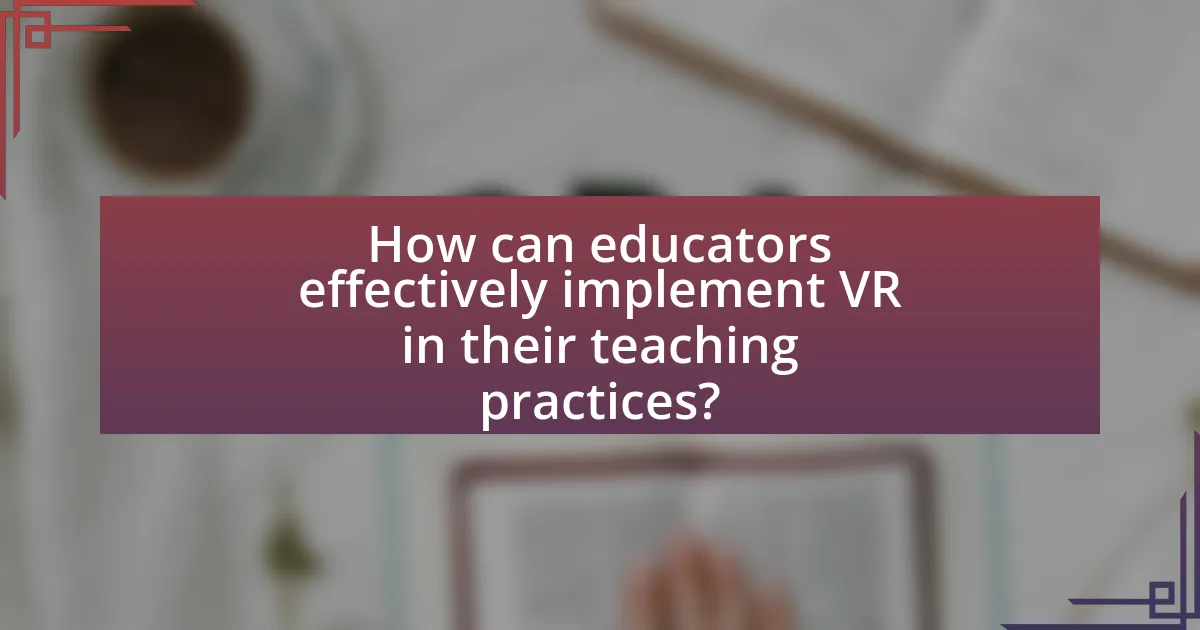
How can educators effectively implement VR in their teaching practices?
Educators can effectively implement VR in their teaching practices by integrating immersive experiences that align with curriculum objectives. This involves selecting appropriate VR content that enhances learning outcomes, such as simulations for science experiments or historical reconstructions for social studies. Research indicates that VR can improve engagement and retention; for instance, a study by Mikropoulos and Natsis (2011) found that students using VR for learning showed a significant increase in knowledge retention compared to traditional methods. Additionally, educators should provide training for both teachers and students to ensure effective use of VR technology, fostering an environment where learners can explore and interact with content in a meaningful way.
What strategies can educators use to create immersive VR experiences?
Educators can create immersive VR experiences by integrating interactive storytelling, utilizing real-world simulations, and incorporating collaborative elements. Interactive storytelling engages students by allowing them to make choices that affect the narrative, enhancing emotional investment and retention of information. Real-world simulations provide hands-on experiences that mirror actual scenarios, facilitating deeper understanding of complex concepts. Collaborative elements, such as multi-user environments, encourage teamwork and communication, fostering social skills and collective problem-solving. Research indicates that immersive VR can improve learning outcomes by up to 75%, demonstrating its effectiveness in educational settings.
How can storytelling be utilized in VR curriculum design?
Storytelling can be utilized in VR curriculum design by creating immersive narratives that engage learners emotionally and cognitively. This approach enhances retention and understanding by situating educational content within relatable contexts, allowing students to experience scenarios that illustrate key concepts. Research indicates that narratives in educational settings can improve engagement and motivation, as evidenced by a study published in the Journal of Educational Psychology, which found that students who learned through storytelling performed better on assessments compared to those who received traditional instruction. By integrating storytelling into VR, educators can foster a deeper connection to the material, making learning more impactful and memorable.
What role does interactivity play in VR learning environments?
Interactivity is crucial in VR learning environments as it enhances engagement and facilitates active learning. By allowing learners to manipulate virtual objects and navigate immersive scenarios, interactivity promotes deeper understanding and retention of information. Research indicates that interactive VR experiences can lead to improved learning outcomes; for instance, a study by Mikropoulos and Natsis (2011) found that students using interactive VR simulations scored significantly higher on assessments compared to those in traditional learning settings. This evidence underscores the importance of interactivity in fostering an effective educational experience within virtual reality.
How can assessment be adapted for VR-based learning?
Assessment can be adapted for VR-based learning by integrating immersive simulations that evaluate learners’ skills in real-time scenarios. This approach allows educators to assess not only knowledge retention but also practical application and problem-solving abilities in a controlled virtual environment. For instance, studies have shown that VR assessments can provide immediate feedback and track learner progress through analytics, enhancing the overall learning experience. Research by Mikropoulos and Natsis (2011) indicates that VR environments can effectively measure complex competencies, making them suitable for diverse educational contexts.
What types of assessments are most effective in VR settings?
Performance-based assessments are the most effective in VR settings. These assessments allow learners to demonstrate their skills and knowledge in immersive environments, providing a realistic context for evaluation. Research indicates that performance-based assessments in VR can enhance engagement and retention, as they simulate real-world scenarios that require critical thinking and problem-solving. For instance, a study by Mikropoulos and Natsis (2011) found that students who participated in VR-based assessments showed improved learning outcomes compared to traditional assessment methods. This evidence supports the effectiveness of performance-based assessments in virtual reality educational contexts.
How can educators measure student engagement and learning outcomes in VR?
Educators can measure student engagement and learning outcomes in VR through a combination of quantitative and qualitative assessment methods. Quantitative measures include tracking metrics such as time spent in the VR environment, completion rates of tasks, and performance scores on assessments integrated within the VR experience. For example, studies have shown that analyzing user interaction data can provide insights into engagement levels, with higher interaction correlating to increased engagement (Bailenson et al., 2008).
Qualitative assessments can involve student feedback through surveys or interviews, allowing educators to gauge students’ perceptions of their learning experiences in VR. Research indicates that students often report higher motivation and interest when learning in immersive environments, which can be a strong indicator of engagement (Dede, 2009). By combining these methods, educators can obtain a comprehensive understanding of both engagement and learning outcomes in VR settings.
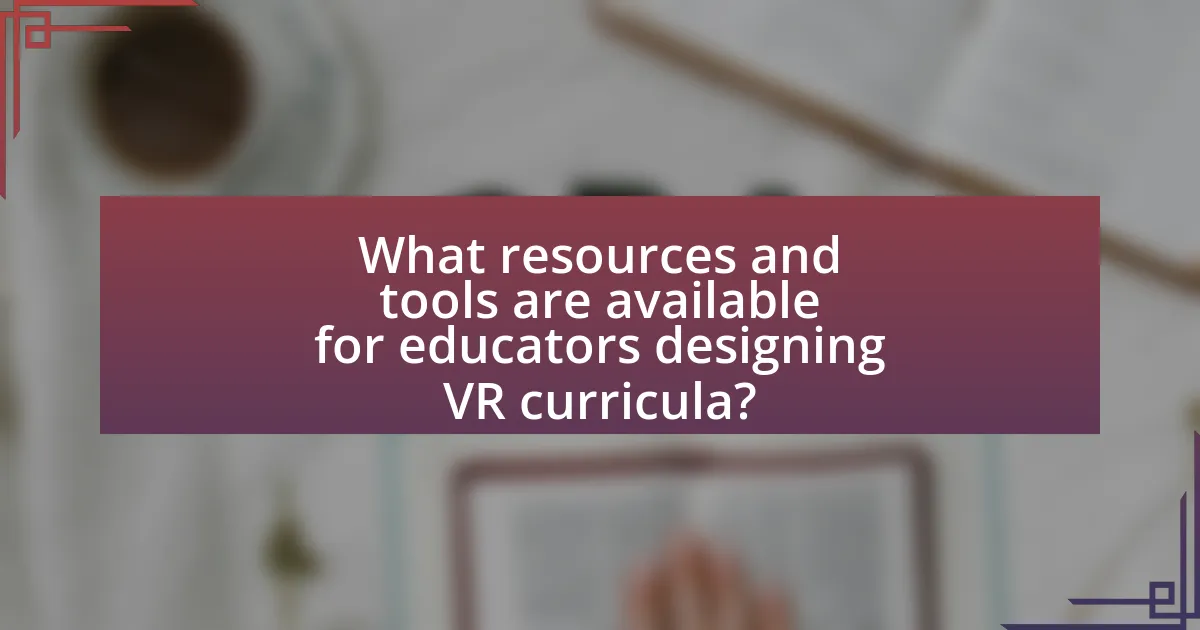
What resources and tools are available for educators designing VR curricula?
Educators designing VR curricula can utilize a variety of resources and tools, including platforms like Unity and Unreal Engine for development, as well as educational resources such as Google Expeditions and Nearpod for immersive experiences. Unity and Unreal Engine provide robust environments for creating interactive VR content, while Google Expeditions offers pre-made VR field trips that can enhance classroom learning. Nearpod allows educators to integrate VR experiences into lessons, facilitating engagement and interactivity. These tools are widely recognized in the educational technology community for their effectiveness in enhancing learning through virtual reality.
What platforms and software can assist in VR curriculum development?
Platforms and software that assist in VR curriculum development include Unity, Unreal Engine, and Google VR. Unity is widely used for creating interactive 3D content and offers extensive resources for educational applications, making it a popular choice among educators. Unreal Engine provides high-fidelity graphics and is suitable for immersive experiences, which can enhance learning outcomes. Google VR offers tools for developing VR applications that are accessible on various devices, facilitating broader reach in educational settings. These platforms are validated by their adoption in numerous educational institutions for creating engaging and effective VR learning experiences.
How do different VR tools cater to various educational needs?
Different VR tools cater to various educational needs by providing immersive experiences tailored to specific learning objectives. For instance, tools like Google Expeditions allow students to explore historical sites and scientific phenomena in a virtual environment, enhancing engagement and retention of information. Similarly, platforms such as Oculus for Business offer simulations for vocational training, enabling hands-on practice in a safe setting, which is crucial for skill acquisition. Research indicates that immersive learning environments can improve knowledge retention by up to 75%, demonstrating the effectiveness of VR in meeting diverse educational requirements.
What are the best practices for selecting VR content for the classroom?
The best practices for selecting VR content for the classroom include ensuring alignment with educational objectives, assessing the content’s interactivity and engagement level, and evaluating the accessibility and usability of the technology. Educators should prioritize VR experiences that directly support curriculum goals, as research indicates that content aligned with learning outcomes enhances student comprehension and retention. Additionally, interactive VR content has been shown to increase student engagement, making it more effective for learning. Accessibility is crucial; therefore, selecting VR content that accommodates diverse learning needs and is user-friendly ensures that all students can benefit from the experience.
How can educators stay updated on VR trends and advancements?
Educators can stay updated on VR trends and advancements by actively engaging with professional development opportunities, subscribing to relevant journals, and participating in online communities. Professional development programs often include workshops and conferences focused on VR technology in education, providing firsthand insights into the latest tools and methodologies. Journals such as the “Journal of Virtual Worlds Research” publish peer-reviewed articles on VR advancements, offering educators research-based information. Additionally, online platforms like LinkedIn groups and forums dedicated to educational technology allow educators to share experiences and resources, fostering a collaborative environment for learning about VR innovations.
What professional development opportunities exist for educators in VR?
Professional development opportunities for educators in virtual reality (VR) include specialized training programs, workshops, and online courses focused on integrating VR technology into teaching practices. These programs often provide hands-on experience with VR tools and platforms, enabling educators to create immersive learning experiences. For instance, organizations like the International Society for Technology in Education (ISTE) offer resources and certification programs that emphasize the effective use of VR in education. Additionally, universities and educational institutions frequently host seminars and conferences that explore the latest advancements in VR technology and its applications in the classroom, allowing educators to collaborate and share best practices.
How can educators collaborate to share VR curriculum ideas and resources?
Educators can collaborate to share VR curriculum ideas and resources through online platforms, professional networks, and collaborative projects. Utilizing platforms like Google Drive or educational forums allows educators to upload and exchange VR lesson plans, share best practices, and provide feedback on each other’s resources. Additionally, participating in professional learning communities or attending conferences focused on VR in education fosters networking opportunities where educators can discuss innovative VR applications and co-create curriculum materials. Research indicates that collaboration among educators enhances resource sharing and improves teaching effectiveness, as seen in studies highlighting the positive impact of peer collaboration on instructional quality.
What are the best practices for troubleshooting common VR issues in education?
The best practices for troubleshooting common VR issues in education include ensuring proper hardware setup, verifying software compatibility, and providing user training. Proper hardware setup involves checking connections, ensuring devices are charged, and confirming that the VR environment is free from obstructions. Software compatibility requires educators to regularly update applications and ensure that the VR content is compatible with the hardware being used. User training is essential, as familiarizing students and educators with the VR system can significantly reduce user errors and enhance the overall experience. These practices are supported by studies indicating that effective troubleshooting can improve user satisfaction and learning outcomes in VR environments.
